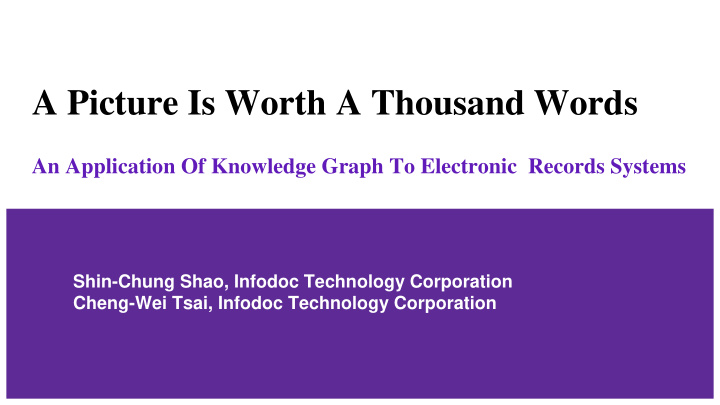



A Picture Is Worth A Thousand Words An Application Of Knowledge Graph To Electronic Records Systems Shin-Chung Shao, Infodoc Technology Corporation Cheng-Wei Tsai, Infodoc Technology Corporation
Contents ● Research Motivation ● Storyboard Like Display -- Our Approach ● Conclusion and Future Research
Research Motivation The Google-Like search interface ●
Research Motivation The search results, a list of links directing to articles, audios, videos, images, may ● themselves related, in the sense that there may be classification rules, association rules, chronicle orders and semantic rules among them, but not appropriately presented. Indeed, those historical electronic assets are history, they have stories involved. ● Therefore, we ask ourselves, can we, insteadly, provide a storyboard-like search results display ?
Storyboard-Like Display When a user inputs “I have a dream”, the system responds something like the following:
Storyboard-Like Display Clicking the + icon of each node, the node expands and displays more nodes:
Storyboard-Like Display The leaf nodes are actually links to web resources, such as Youtube, Wikipedia.
Storyboard-Like Display Clicking any leaf node will display the contents of the target web resource:
Our Approach ● Each ER is associated with a set of metadata, featuring the Person, Events, Places, Time, and Facilities ( 人事時地物 ) ● Metadata are first stored in a relational database, and then used as keywords to search internal and external resources using crawlers. ● Search results are then analyzed using Entity- Relationship Analyzer, or called Inference Engine. ● Analyzed results, nodes and links, are then stored in Graph database Neo4j (Open Source). ● When a user inputs a keyword, the search engine searches the graph database, and presents the results using data visualization tool, 3d-force-graph (Open Source)
Our Approach The entity- relationship’s are actually nodes and arcs. Each node represents a ● feature, or a web resource, and each arc represents a semantic rule, an association rule, a classification rule or a chronical order between two nodes. Therefore, they are best to presented as networks. In implementing the Entity- Relationship Analyzer, we use “semantic web” or ● “semantic network”, machine learning, natural language processing (NLP), and data mining techniques, however, we are still working on turning the analyzer. Our approach is, by no means, a substitute of Google-Like search approach, but ● instead, we provide an alternative manner to display search results as storyboard, which, we think, is more appropriate for electronic records containing historical, cultural contents.
Future Research This research is still in the infancy stage, from the development of the prototype ● system, we learned the following lessons and future research directions: How to filter out irrelevant information, skip web pages containing repetitive, false, doubtful, ○ unnecessary information? How to enhance the functionality of the Entity-Relationship Analyzer, e.g., exploiting more ○ advanced semantic network or data mining techniques? How to enhance disambiguation? ○ How to determine the optimal number of degrees of a network, i.e., the size of the network? ○ How to deal with ad-hoc web pages, i.e., the page contents are dynamically generated on demand, ○ therefore, crawler cannot grab their dynamic contents.
Thank You! ● Comments? ● Suggestion?
Recommend
More recommend